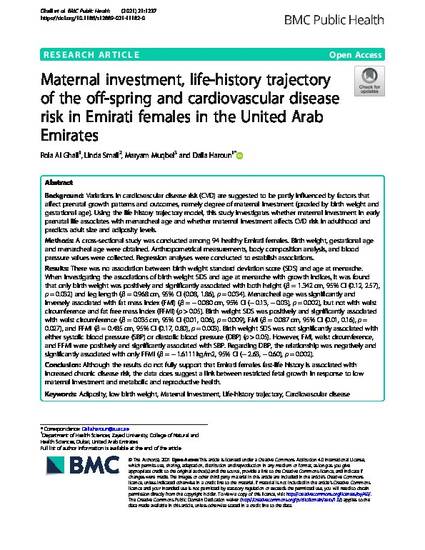
Background: Variations in cardiovascular disease risk (CVD) are suggested to be partly influenced by factors that affect prenatal growth patterns and outcomes, namely degree of maternal investment (proxied by birth weight and gestational age). Using the life history trajectory model, this study investigates whether maternal investment in early prenatal life associates with menarcheal age and whether maternal investment affects CVD risk in adulthood and predicts adult size and adiposity levels. Methods: A cross-sectional study was conducted among 94 healthy Emirati females. Birth weight, gestational age and menarcheal age were obtained. Anthropometrical measurements, body composition analysis, and blood pressure values were collected. Regression analyses were conducted to establish associations. Results: There was no association between birth weight standard deviation score (SDS) and age at menarche. When investigating the associations of birth weight SDS and age at menarche with growth indices, it was found that only birth weight was positively and significantly associated with both height (β = 1.342 cm, 95% CI (0.12, 2.57), p = 0.032) and leg length (β = 0.968 cm, 95% CI (0.08, 1.86), p = 0.034). Menarcheal age was significantly and inversely associated with fat mass index (FMI) (β = − 0.080 cm, 95% CI (− 0.13, − 0.03), p = 0.002), but not with waist circumference and fat free mass index (FFMI) (p > 0.05). Birth weight SDS was positively and significantly associated with waist circumference (β = 0.035 cm, 95% CI (0.01, 0.06), p = 0.009), FMI (β = 0.087 cm, 95% CI (0.01, 0.16), p = 0.027), and FFMI (β = 0.485 cm, 95% CI (0.17, 0.80), p = 0.003). Birth weight SDS was not significantly associated with either systolic blood pressure (SBP) or diastolic blood pressure (DBP) (p > 0.05). However, FMI, waist circumference, and FFMI were positively and significantly associated with SBP. Regarding DBP, the relationship was negatively and significantly associated with only FFMI (β = − 1.6111 kg/m2, 95% CI (− 2.63, − 0.60), p = 0.002). Conclusion: Although the results do not fully support that Emirati females fast-life history is associated with increased chronic disease risk, the data does suggest a link between restricted fetal growth in response to low maternal investment and metabolic and reproductive health.
- Adiposity,
- low birth weight,
- Cardiovascular disease,
- Life-history trajectory,
- Maternal investment
Available at: http://works.bepress.com/linda-smail/15/
